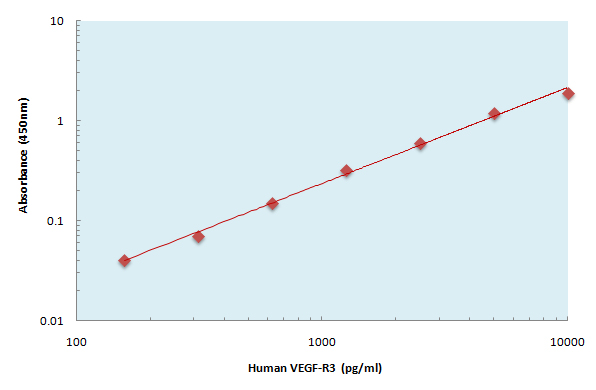Human VEGF-R3 ELISA Kit
- Catalog No.:KE1161
- Applications:ELISA
- Reactivity:Human
- Gene Name:
- FLT4
- Protein Name:
- Vascular endothelial growth factor receptor 3
- Human Gene Id:
- 2324
- Human Swiss Prot No:
- P35916
- Mouse Swiss Prot No:
- P35917
- Specificity:
- Sample Type for Cell Culture Supernates, Cell lysates, Tissue Lysates, Serum, EDTA Plasma, Heparin Plasma
- Storage Stability:
- 2-8°C/6 months
- Other Name:
- FLT4;VEGFR3;Vascular endothelial growth factor receptor 3;VEGFR-3;Fms-like tyrosine kinase 4;FLT-4;Tyrosine-protein kinase receptor FLT4
- Detection Method:
- Colorimetric
- Background:
- catalytic activity:ATP + a [protein]-L-tyrosine = ADP + a [protein]-L-tyrosine phosphate.,disease:Defects in FLT4 are found in juvenile hemangioma. Juvenile hemangiomas are the most common tumors of infancy, occurring as many as 10% of all births. These benign vascular lesions enlarge rapidly during the first year of life by hyperplasia of endothelial cells and attendant pericytes, and then spontaneously involute over a period of years, leaving loose fibrofatty tissue.,disease:Defects in FLT4 are the cause of lymphedema hereditary type 1 (LYH1A) [MIM:153100]; also known as Nonne-Milroy lymphedema or Milroy disease. Hereditary lymphedema is a chronic disabling condition which results in swelling of the extremities due to altered lymphatic flow. Patients with lymphedema suffer from recurrent local infections and physical impairment.,function:Receptor for VEGFC. Has a tyrosine-protein kinase activity.,online information:FLT4 entry,similarity:Belongs to the protein kinase superfamily. Tyr protein kinase family.,similarity:Belongs to the protein kinase superfamily. Tyr protein kinase family. CSF-1/PDGF receptor subfamily.,similarity:Contains 1 protein kinase domain.,similarity:Contains 7 Ig-like C2-type (immunoglobulin-like) domains.,tissue specificity:Placenta, lung, heart, and kidney, does not seem to be expressed in pancreas and brain.,
- Function:
- protein amino acid phosphorylation, phosphorus metabolic process, phosphate metabolic process, cell surface receptor linked signal transduction, enzyme linked receptor protein signaling pathway, transmembrane receptor protein tyrosine kinase signaling pathway, positive regulation of cell proliferation, phosphorylation, regulation of cell proliferation, vascular endothelial growth factor receptor signaling pathway,
- Subcellular Location:
- Cell membrane ; Single-pass type I membrane protein. Cytoplasm . Nucleus . Ligand-mediated autophosphorylation leads to rapid internalization. .; [Isoform 1]: Cell membrane; Single-pass type I membrane protein. Ligand-mediated autophosphorylation leads to rapid internalization.; [Isoform 2]: Cell membrane; Single-pass type I membrane protein.; [Isoform 3]: Secreted. Cytoplasm.
- Expression:
- Detected in endothelial cells (at protein level). Widely expressed. Detected in fetal spleen, lung and brain. Detected in adult liver, muscle, thymus, placenta, lung, testis, ovary, prostate, heart, and kidney.
- June 19-2018
- WESTERN IMMUNOBLOTTING PROTOCOL
- June 19-2018
- IMMUNOHISTOCHEMISTRY-PARAFFIN PROTOCOL
- June 19-2018
- IMMUNOFLUORESCENCE PROTOCOL
- September 08-2020
- FLOW-CYTOMEYRT-PROTOCOL
- May 20-2022
- Cell-Based ELISA│解您多样本WB检测之困扰
- July 13-2018
- CELL-BASED-ELISA-PROTOCOL-FOR-ACETYL-PROTEIN
- July 13-2018
- CELL-BASED-ELISA-PROTOCOL-FOR-PHOSPHO-PROTEIN
- July 13-2018
- Antibody-FAQs
- Products Images

- The Human VEGF-R3 ELISA Kit allows for the detection and quantification of endogenous levels of natural and/or recombinant Human VEGF-R3 proteins within the range of 157-10000 pg/ml.



